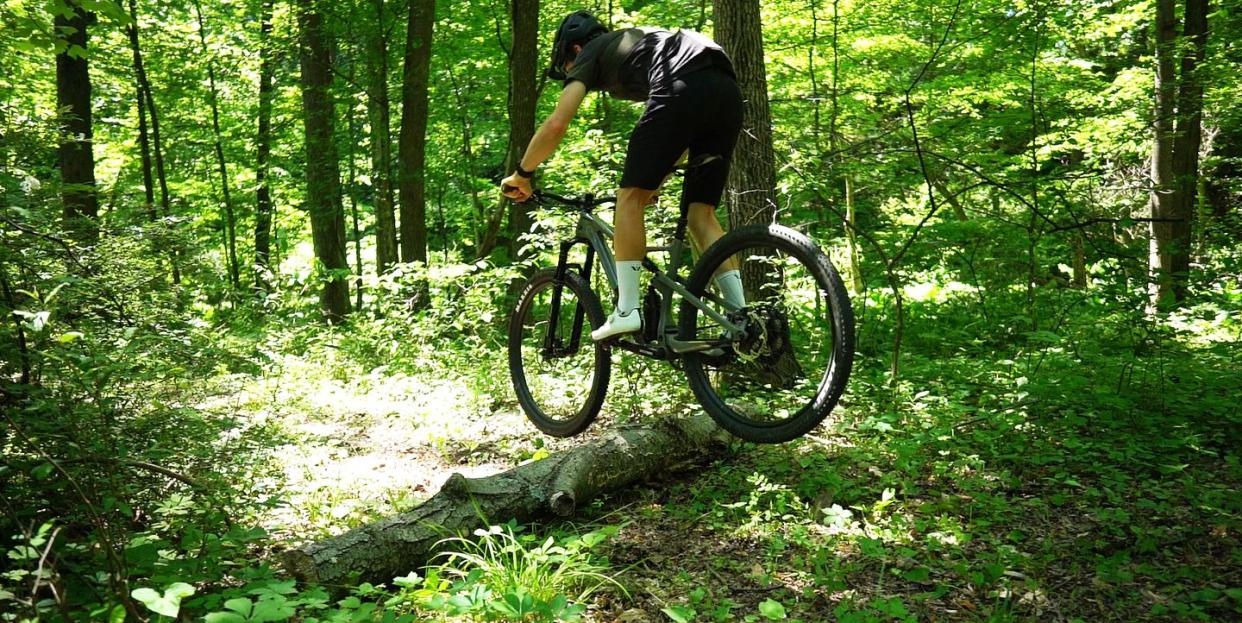Learn How to Bunny Hop (the Right Way!) With These Pro Tips

Big air isn’t just for mountain bikers. Knowing how to boost it on a road bike or a cross bike will let you soar over obstacles like railroad tracks, potholes, or a kamikaze squirrel without slowing down.
This bike trick, when you lift your front end and then your back end up over an obstacle, is one of the most helpful cycling skills you can have in your arsenal. Performed correctly, it allows you to ride smoother and faster in more places, no matter what type of bike you’re on.
It can also save your butt at the last minute. “I’ve had to jump oversize curbs and hop over crashed people and bikes,” says former crit and cyclocross racer Luke Keough.
Beyond the practical upsides, it’s just really freaking fun to do. Even if you never actually catch air like a cottontail, learning the fundamentals of a bunny hop will make you a better rider. Here’s how it’s done.
[Gravel! prepares you with everything you need to know to crush it, including the best gear, how to train, and much more!]
How to Bunny Hop
Mastering this move takes some practice. First, study the sequence below and take note of the tips we sourced from cycling coaches. Then grab your bike and head to a safe area such as a backyard or an empty parking lot. Practicing in a yard or grassy field provides a slightly softer landing zone than asphalt should anything go wrong.
Set up a “place holder” obstacle like a rolled up towel or T-shirt (in a parking lot, you can use the painted lines.) This allows you to practice clearing something without the risk of bonking the front tire and wiping out hard (if you don’t clear it, you simply roll over it).
Once you clear the towel or painted line, increase the size of the obstacle incrementally until you feel confident enough to try this move on a real branch, log, or curb.
1. Set it up.
Though talented trials riders can bunny hop from a stand-still, the rest of us need some speed. Approach the obstacle at about 10 mph or at cruising speed, so you have enough momentum to complete the move. About three feet away from the obstacle, stand up out of the saddle with your pedals level horizontally. Keep your elbows and knees loose and bend at the hips (often called a ready position in mountain biking), so you are positioned over the saddle but not behind it.
Tip: Don’t grip the saddle with your thighs—if you struggle to find balance standing, lower the saddle and practice pedaling and cornering in this position before progressing. If you’re on a mountain bike with a dropper post, drop the saddle low.
2. Lift the front wheel first.
It may seem intuitive to simply hop off the ground with both wheels at once—and that can work if you have enough speed—but learning to lift the front wheel first will allow you to clear larger obstacles easier and more safely as you continue to progress. Your goal is to arc over the object smoothly.
To do so, crouch into the bike by shifting your weight forward into your handlebars and pedals to load the suspension. Once loaded, pull the front wheel up and off the ground with your arms while pushing your feet into the pedals.
3. Finish and follow through.
As the front wheel comes up, lean your weight forward and, once you see the front wheel clear the obstacle, push the handlebar forward (away) and down as you simultaneously suck your legs up toward your body to bring the bottom bracket and rear wheel up and over the obstacle. Some coaches describe this step as “scooping backward with your feet” as you are sucking the bike up underneath you.
Tip: Remember to stay off the brakes as you come down the other side, unless you want to endo (go end over end over your handlebars) spectacularly. For this skill, brakes are the enemy, and momentum is your friend.
Practice Tips:
If you are a road or cyclocross cyclist looking to bunny hop, and you have access to a mountain bike or hardtail, start there. Learning how it feels to load a bike with suspension will help you master this move on a stiffer road bike.
Once you advance, you can work on clearing larger and larger obstacles or practicing variations of the move, like a nose bonk, where you tap the obstacle with your front wheel intentionally.
You Might Also Like

